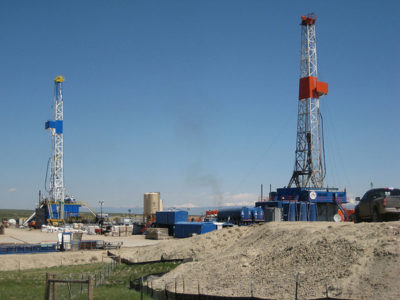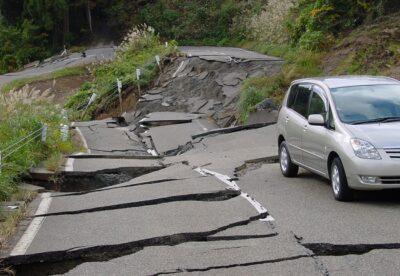Residents of Oklahoma should prepare themselves for a major earthquake in the near future, the United States Geological Survey (USGS) has warned, and the rest of the country should take notice.
The survey’s scientists say that a dramatic increase in the number of smaller quakes in the state could be a sign that a damaging earthquake is imminent. All of it could be due to fracking — and roughly half the states allow such drilling.
“The rate of earthquakes increased dramatically in March and April,” USGS research geophysicist Robert Williams told the website Live Science. “That alerted us to examine this further and put out this advisory statement.”
There have been more than 140 earthquakes of magnitude 3.0 or greater in the first four months this year. For all 12 months last year, there were 109 similar ones.
USGS experts are so concerned about the seismic activity in Oklahoma that they issued May 5 their first-ever earthquake advisory warning for a state east of the Rocky. Scientists say that an earthquake with a force of magnitude 5.0 or greater could be imminent.
Almost as Many Earthquakes in Oklahoma as in California
There have been almost as many earthquakes in Central Oklahoma as in California this year, Live Science said. Such increases in seismic activity often precede major earthquakes.
“We haven’t seen this before in Oklahoma, so we had some concerns about putting a specific number on the chances of it,” Williams noted. “But we know from other cases around the world that if you have an increasing number of small earthquakes, the chances of a larger one will go up.”
Geophysicists are unable to predict the exact time of a major earthquake and instead can only guess when and where it will be.
Could be a Major Disaster
The results of a major earthquake in Central Oklahoma could be catastrophic because a major metropolis, Oklahoma City, is located in the area. One of the nation’s busiest and most important highways, Interstate 40, also runs through that region, as do major railroad lines and pipelines.
Persons who live in the area should be concerned particularly if they live or work in an older structure. Such buildings are more likely to collapse.
 “Building owners and government officials should have a special concern for older, unreinforced brick structures, which are vulnerable to serious damage during sufficient shaking,” USGS Science adviser Bill Leith said.
“Building owners and government officials should have a special concern for older, unreinforced brick structures, which are vulnerable to serious damage during sufficient shaking,” USGS Science adviser Bill Leith said.
There are no nuclear power plants in Central Oklahoma but there are some in nearby states, according to CNN.
Related to Fracking?
There has been some speculation that the increased seismic activity in Oklahoma could be the result of fracking — the use of injection wells to extract oil and gas from the ground. Last year, Austin Holland, a seismologist with the Oklahoma Geological Survey, published a study that indicated there might be a link between fracking and earthquakes in Oklahoma.
Another recent study showed that fracking can trigger earthquakes up to 30 miles away from drilling sights. Oklahoma is one of the most heavily fracked regions in the country with thousands of oil and gas wells.
“Even though only a small fraction of injection wells do induce damaging earthquakes, there are so many injection operations that these operations have materially contributed to the seismic hazard in the U.S.,” USGS Geophysicist Art McGarr told Live Science. “In states like Oklahoma, where wastewater continues to be injected, I think it’s highly likely we will continue to see larger earthquakes there.”
Research indicates that tremors in Ohio, Colorado, Arkansas and Texas also might have been caused by fracking.
“We can’t guarantee the earthquakes aren’t a coincidence,” Holland said. “But it would be a pretty remarkable coincidence.”
Holland is not the only scientist who believes fracking might be causing quakes.
“I’d say it certainly looks very possible that the earthquakes are related to injection wells,” Cliff Frolich, an earthquake researcher at the University of Texas, told TV station KHOU. Most fracking techniques involve the injection of liquids into wells.
Recent seismic activity in areas with lots of fracking includes:
- 109 earthquakes that struck the region around Youngstown, Ohio, starting in December 2010. No earthquakes had ever been reported in Youngstown even though settlers have lived in the area since 1776. The quakes began when companies started fracking for natural gas in the Marcellus Shale. Shortly after work began Youngstown was struck by a 3.9 magnitude earthquake on Dec. 31, 2011. “Earthquakes were triggered by fluid injection,” Columbia University seismologist Won-Young Kim told NBC News. Kim noted that the earthquakes began less than two weeks after fracking started near Youngstown. Fracking-related earthquakes got so bad in Ohio that in January, 2012, the state’s legislature put a temporary ban on the practice.
- The town of Azle, Texas, near Fort Worth was struck by 16 earthquakes in the first three weeks of November. The US Geological Survey recorded at least one earthquake of 3.6 on the Richter scale. The quakes have gotten so frequent that local residents are now worried about them. “What if a 5.0 (magnitude earthquake) happens and people’s houses start falling down on them,” Azle’s mayor Alan Brundrett asked a reporter. Keith Krayer, a resident of Briar, near Azle, said his wife was having panic attacks because of the quakes. Krayer described one quake as sounding like a sonic boom.
The number of magnitude 3 earthquakes in central North America increased from 29 in 2008 to 134 in 2012, the United States Geological Survey reported.
Do you believe fracking causes earthquakes? Let us know in the comments below.
Sign up for Off The Grid News’ weekly email and stay informed about the issues important to you
 Off The Grid News Better Ideas For Off The Grid Living
Off The Grid News Better Ideas For Off The Grid Living




